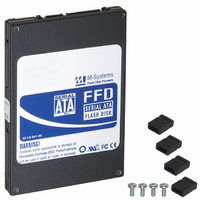SD8NA-072G-000000 SanDisk, SD8NA-072G-000000 Datasheet - Page 61

SD8NA-072G-000000
Manufacturer Part Number
SD8NA-072G-000000
Description
SSD ULTRA320 SCSI 72GB
Manufacturer
SanDisk
Series
Ultra320r
Datasheet
1.SD8NA-104G-000000.pdf
(70 pages)
Specifications of SD8NA-072G-000000
Memory Size
72GB
Memory Type
FLASH
Lead Free Status / RoHS Status
Lead free / RoHS Compliant
Other names
FFD35-U3S-72-N-P80-P
FFD35-U3S-72-N-P80-P
FFD35-U3S-72-N-P80-P
Q: What is Ultra320 SCSI?
A; Ultra320 devices transfer data and commands using packetized SCSI. Packetized SCSI
Q: What is plug-and-play SCSI?
A: Plug-and-play SCSI is an extension to the generic plug-and-play specification. P&P is an
Q: What is SCSI Configured Automatically (SCAM)?
A: SCAM is a protocol for automatic SCSI ID assignment. It is included in the SCSI-3 parallel
Q: What is a SCSI ID?
A: Every SCSI device must have a unique ID on the bus. For this reason, most devices have
61
provides a method for transferring command and status information at the maximum data
rate on the parallel SCSI bus. Packetized SCSI is referred to as Information Unit (IU)
transfers in the ANSI SPI standards. In addition, a method for decreasing the overhead
associated with arbitration and selection called Quick Arbitration and Selection (QAS),
along with a method to provide bus utilization fairness, have been introduced in the Ultra320
standard.
Ultra320 features include:
o
o
o
o
o
approach for defining an auto-configuring environment for ISA boards. One of the key
features of P&P-SCSI is SCAM.
interface drafts. The SCAM master (typically the host adapter), scans the bus for attached
SCSI devices. For compatibility, it also needs to find and identify legacy, i.e., standard,
SCSI devices. Thus the SCAM master obtains a map of the attached devices and assigns a
valid soft ID for each SCAM-compliant SCSI device. After this process, the SCAM master
keeps this device table in non-volatile memory to provide an identical ID setup for further
boot processes.
three ID jumpers to set the SCSI ID from 0 to 7. In most cases, ID 7 is reserved for the host
adapter and ID 0 is used for a boot device, typically a hard drive. ID 1 can be used for a
second hard drive, although this is not a requirement. ID 2 and up are typically used for
other devices, with ID 2 being a common ID for CD ROMs. With the exceptions of ID 0 and
7, there is no particular ID that has to be assigned to any device type. Additionally, every ID
can have up to seven sub-units identified by a LUN (Logical Unit Number). Thus, you can
address multiple devices through one ID. Using four ID jumpers, SCSI-3 allows up to 16
devices on the same bus
Paced data transfer: Packetized SCSI
Free-running clock (ACK, REQ, and P1 for valid data)
ISI (Intersymbol Interference) Compensation: Precomp drivers and Adaptive Active
Filter receivers
Skew compensation
Training pattern for the Adaptive Active Filters and the skew compensation
Product Specification and User Manual
SSD (Formerly FFD) Ultra320 SCSI 3.5"
43-PS-0305-00 Rev. 2.2












